The Popecol annual group retreat is over for another year. Which is probably for the best.
If you are interested in what happens when a bunch of scientists go away to the mountains for two days, take a look at the video below.
Chris
The Popecol annual group retreat is over for another year. Which is probably for the best.
If you are interested in what happens when a bunch of scientists go away to the mountains for two days, take a look at the video below.
Chris
About one third of the Swiss landscape offers suitable wolf habitat. Nonetheless, there is only a small fraction thereof where the wolf is tolerated by local communities. Those regions – characterized by both favourable environmental conditions and a positive attitude towards the wolf – are identified as candidate regions for the successful short to medium-term wolf expansion, according to a study conducted by the population ecology research group at the University of Zurich
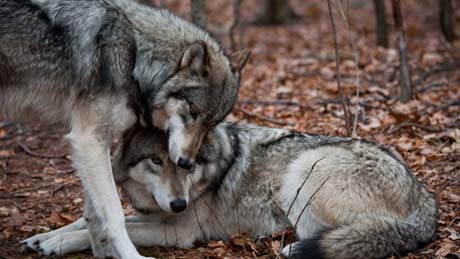
The wolf was eradicated in Switzerland and from large parts of continental Europe including France and Germany by the end of the 19th century. Following legal protection, the wolf population started naturally increasing and expanding, and in 1995 its presence was confirmed in Switzerland. Sightings have increased since. Despite 13’800 km2 of Switzerland are characterized by favourable conditions such as large forests with little human pressure and have thus been identified as suitable wolf habitat, wolf expansion in Switzerland has been substantially slower than in other parts of continental Europe. As the wolf is more and more subject to human-dominated landscapes, scientist at the University of Zurich developed a novel method that integrated both ecological and human components to identify regions with favourable environmental conditions and where the wolf was tolerated.
Mapping human acceptance of the wolf to identify suitable socio-ecological areas
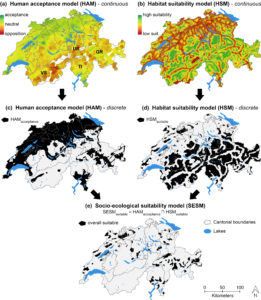
About one third of 10,000 randomly selected residents in Switzerland participated in the survey. Combining the response from questionnaires with geographical information, Dominik Behr and his team created a nationwide map of human acceptance. Acceptance decreased with increasing altitude of residency and even more so where high numbers of sheep and goats were held. Acceptance increased with increasing distance from confirmed wolf presence and in densely populated areas. People who perceived the wolf as dangerous to humans and harmful to livestock and wildlife mainly opposed the wolf. Younger people, and people who believe that the wolf had a positive influence on the ecosystem had a more positive attitude towards the predator.
“When we overlapped our human acceptance map with a habitat suitability map for the wolf, we realized that only about 6% of Switzerland was characterized by both a positive attitude and favourable environment conditions. This was in contrast to results from the habitat suitability map, which returned one third of the Swiss landscape as being suitable for the wolf” said Dominik Behr. “As wildlife biologists, we are good at understanding the ecological factors determining the suitability of a habitat for a wildlife species. Due to ever-increasing overlap between human and wildlife, however, we are obliged to take into consideration how human acceptance modifies our ecological description of habitat suitability. This study demonstrates one effective way to do this.” stressed Arpat Ozgul, professor of population ecology at the Department of Evolutionary Biology and Environmental Studies at the University of Zurich, and co-author of the study.
A novel framework to manage wolves and people
The socio-ecological map created by Dominik Behr and his co-authors appears to accurately represent the wolf situation in Switzerland of the past years, including identifications of areas of high, moderate or limited conflict. “By capturing areas characterized by both favourable environmental conditions and a positive acceptance towards the wolf, our approach is a valuable tool to identify overall socio-ecological suitable areas for the wolf. Under given conditions, those regions are good candidates for the successful short to medium-term expansion of the wolf. Additionally, this approach allows to identify key regions where proactive and targeted socio-ecological management plans and a constructive dialog among different stakeholders are needed” said Dr. Gabriele Cozzi, who coordinated the study.
Special thanks go to the 3142 people that returned the completed questionnaire – this study would not have been possible without their contribution.
Behr DM, Ozgul A, Cozzi G (2017) Combining human attitude and habitat suitability: a unified socio-ecological suitability model for the wolf in Switzerland. Journal of Applied Ecology ➤
written by Megan
My name is Megan, and I was an intern in this lab over the summer in the Biology Undergraduate Summer School, or BUSS program. That’s a very simple way of summing up all the amazing experiences I had thanks to the program and my host lab, and I think it would be best to start this blog post by talking about the BUSS program itself.
The BUSS program aims to unite students from all over the world with varying levels of experience in different biological fields to teach them new and exciting things. It was inspirational to witness the kind of devotion amongst all the people I had the pleasure to meet. The program allowed me to learn about topics from various fields, especially those outside of what I was used to. Seminars, retreats, and interactions with some of the top researchers reminded me of why I enjoy science so much. I was guided through by these amazing mentors as well as my peers who attended the program with me and the two months went by very quickly.
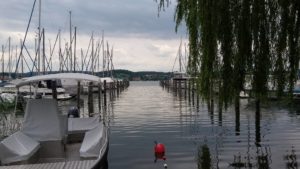
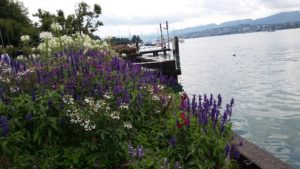
Zürich in summer (photos taken by Megan)
I worked with Koen van Benthem in theoretical biology on modelling techniques and gained new skills in different programming languages, practiced giving scientific presentations, and even learned to LaTex. My project itself was working on increasing the biological significance of Inverse Integral Projection models which use maximum likelihood to estimate parameters such as survival and growth within populations. As always, it was difficult to get started on a new project, but my host lab was very supportive. I learned many techniques and got to discover what theoreticians do. I also got to hear about all the things the other members of the lab do; and they’re all truly extraordinary people who really care about their work. Perhaps most importantly, it was very obvious to me that this lab works well as a unit. There was so much friendship and it was a wonderful environment; that’s an extremely important thing when you’re learning.
Altogether it was an extraordinary experience, and thank you to all who allowed me to come here and took the time to make feel so welcome.
As researchers and conservationists, a key component of our work is to make our research findings accessible to everybody and engage with the general public. This is particularly important for sensitive and ‘political’ topics such as the recolonisation of the Swiss territory by large carnivores.
Gabriele talks to adults and children about his work on bears in Turkey and wolves in Switzerland, as part of the Grimm’s special exhibition organised by the Zürich Zoological Museum. If you are keen to learn more and talk to Gabriele, do not miss the next opportunity on Sunday 29th January 2017 at 11:30 in the museum main building.
Series of congratulations to Dominik on three wonderful achievements!
First and foremost, he managed to persuade a wonderful lady, Regula, to tie the knot. We wish them a long and happy life together. May they grow old on one pillow!
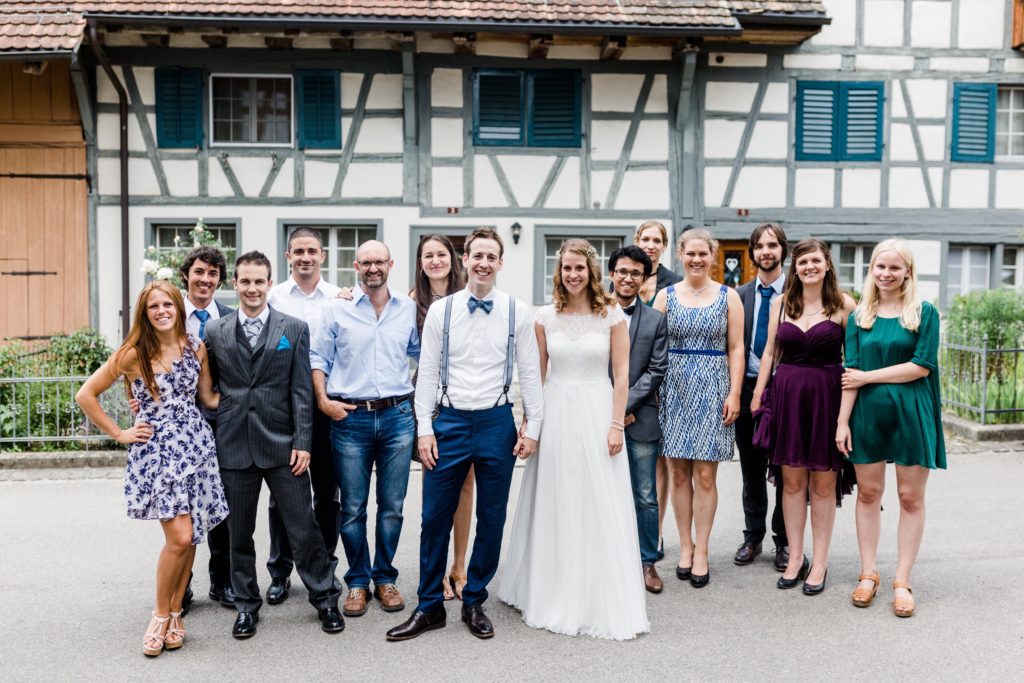
Secondly, he successfully attracted third-party funding to support his PhD study on wild dog dispersal in Botswana, and started his PhD work. He is currently out and about, gps-collaring wild dogs together with Gabriele.
Last but not the least, he just received the Albert Heim Foundation’s 2016 Science Award, with his MSc work on the Swiss wolves. This award is given annually to outstanding work by young researchers in Swiss universities. The broad spectrum of research includes various disciplines around canines, including interdisciplinary issues such as the human-wolf relationships, which Dominik has nicely studies during his MSc. He sure will be a promising contender again with his new canine sp. in the upcoming years.
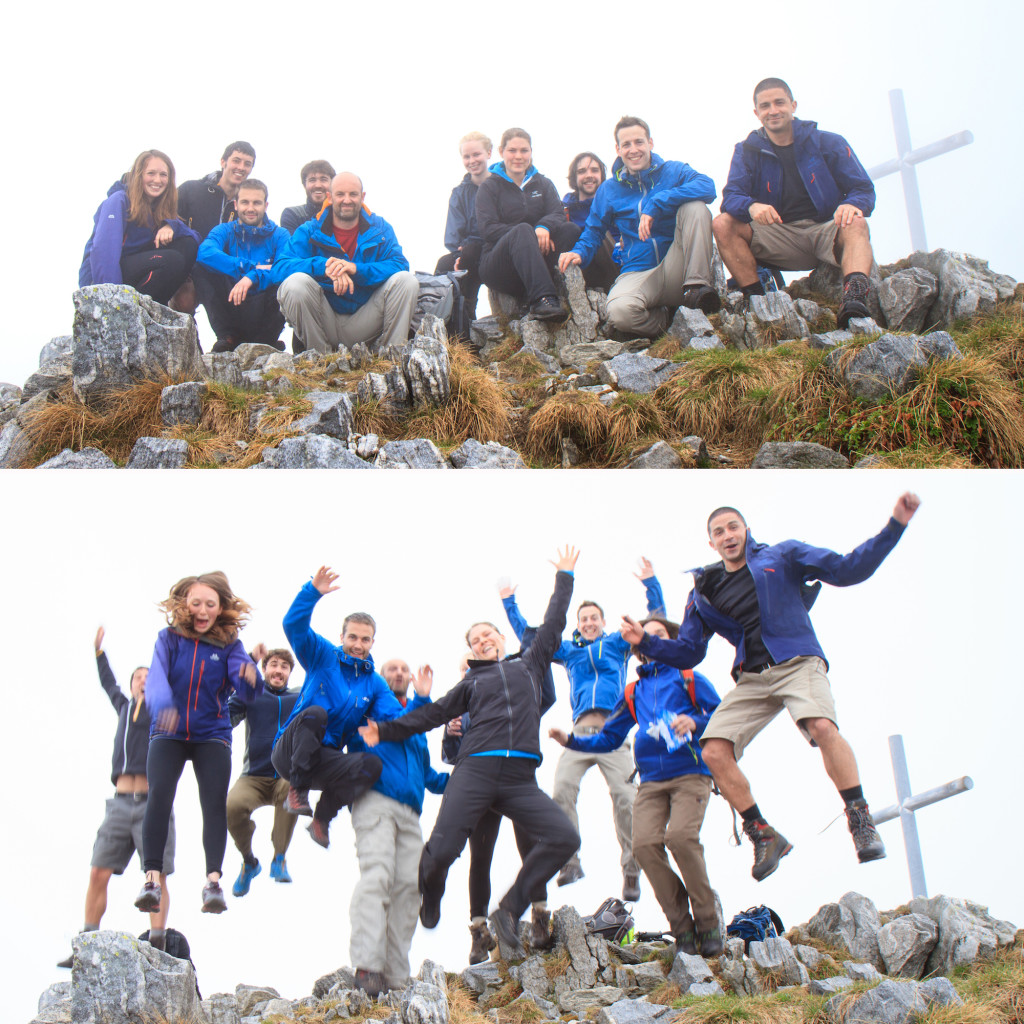
This year, our group retreat was in Ticino. It involved ten group members, climbing up 1000m from Mergoscia to Cimetta, staying overnight at the top, and coming back down the next day. A great escape from “winter” in M̶o̶r̶d̶o̶r̶ Zurich. Thanks to Gabriele for organising the retreat and Chris for putting together this video summary:
https://www.youtube.com/watch?v=0Ew-fRwAJeg
Having lived my entire life in the Northern Hemisphere amidst humans, it was with a heady concoction of childlike enthusiasm and amazed disbelief that I made my way through 31 hours of buses, trains, flights, queues, halts and drives to the Southern Hemisphere to spend two weeks with animals. I keep having to pinch myself from time to time to check if these dreamy places my academic pursuits carry me to are not just wishful figments of my imagination – first Switzerland, then California, and now the Kalahari desert in South Africa! Three continents! With shining eyes, I watched from the very edge of the car seat as my inward excitement seemed to be reflected in the gloriously red sunset illuminating two gigantic halves of the sky – one serenely reflecting the receding rays of the summer sun (summer in February! Something I hadn’t even dreamt of experiencing!), and the other ravaged by a colossal storm split open every so often by humongous lightning strikes. Here’s a picture of how the sky looked like from my car window (did not manage to get the lightning strikes in this one though).
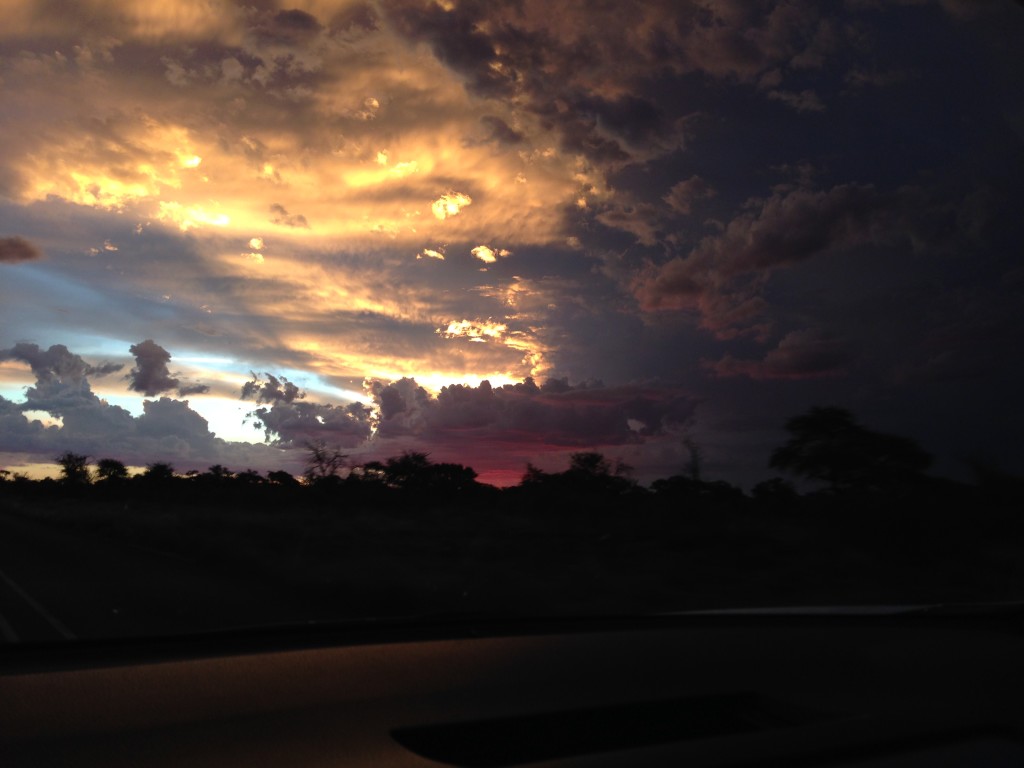
My PhD is about understanding the process of dispersal in meerkats using inertial sensors such as accelerometers, magnetometers and gyroscopes. The idea of extracting meerkat behaviour just from signals recorded on these sensors fascinates me, and I could have spent 4 years immersed in this world of signals, processing techniques and interpretations. But to have the unbelievable fortune to go to the very place these signals come from and actually see wild meerkats prancing about in the sands of the Kalahari desert, creating new dispersal strategies and group dynamics in real time in their own environment and according to their own mysterious rules, is something that makes me send out intense beams of gratitude into the universe every now and again. The Kalahari Meerkat Project is situated at the Kuruman River Reserve – a river that last flowed about a 100 years ago now lies as a flat bed surrounded by different shades of sand (whitish to yellowish to reddish) and low, flat dunes dotted with thorny shrubs and acacia trees. The first picture below shows the Kuruman river bed, and the second one shows the typical landscape seen in this part of the Kalahari.
This place is home to a mind-boggling assortment of desert fauna such as meerkats (charismatic creatures who seem to be in a perennial state of urgency), warthogs (Pumba!), desert squirrels (rather arrogant, look like balloons), leopard and tented tortoises (named so because of the respective patterns on their shells), bat-eared foxes (which surprisingly almost exclusively eat termites; they’re nocturnal and prefer periods of lower temperatures; they’re currently being ravaged by an outbreak of rabies in the region), aardvarks (phenomenal diggers that use the three huge claws on their paws to create holes 1.5 – 2m deep!), porcupines (also great diggers that find a juicy shrub-root, dig into the sand to reach the tuber, and eat the plant from the inside out), and pangolins (so elusive that even experienced field biologists there had seen just 3-4 in their time).
Coming to the ungulates, there are springbok (identified by the white underbelly), steenbok (identified by the big ears and smaller size), hartebeest (similar to steenbok, but usually much bigger in size and with less prominent ears), gemsbok (huge antlered beasts almost as big as adult cows but more muscled and mobile, also known as Oryx, which by the way is also the name of the entertainment software in Qatar Airways flights), wildebeest, duiker (a kind of antelope), some common elands (second largest antelopes in the world, after the giant eland), and giraffes (introduced artificially by some farmers here). There are also African wild cats, spring hares (look like miniature kangaroos, are actually rodents), and wild hares (usually nocturnal, and go toing-toing-toing as soon as you catch them in your car headlights).
Birds include pied babblers (named so because t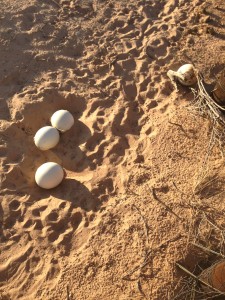 he sound they make resembles ‘babbling’), yellow-billed hornbills (unexpectedly heavy – I was sitting on the branch of a tree near the Farmhouse writing down my observations of the day when I almost toppled over because the branch started shaking suddenly even though there was no wind. I looked up to see that a hornbill couple had landed on the end of my branch and were probably deciding whether I deserved to sit on the same branch as them. In hindsight, the branch probably moved so much because of the greater torque resulting from the big radius arm, since they settled at the end of the long branch), ostriches (when they run with the car you’re driving in, it looks like a scene from Jurassic Park – the claws on their feet look just like those that the velociraptors had! Their huge eggs are shown in the picture below – unfortunately I did not have time to put anything for size-reference – the mother was running after us!), and many others I do not know of.
he sound they make resembles ‘babbling’), yellow-billed hornbills (unexpectedly heavy – I was sitting on the branch of a tree near the Farmhouse writing down my observations of the day when I almost toppled over because the branch started shaking suddenly even though there was no wind. I looked up to see that a hornbill couple had landed on the end of my branch and were probably deciding whether I deserved to sit on the same branch as them. In hindsight, the branch probably moved so much because of the greater torque resulting from the big radius arm, since they settled at the end of the long branch), ostriches (when they run with the car you’re driving in, it looks like a scene from Jurassic Park – the claws on their feet look just like those that the velociraptors had! Their huge eggs are shown in the picture below – unfortunately I did not have time to put anything for size-reference – the mother was running after us!), and many others I do not know of.
Coming to the insects and crawling creatures, there are vibrantly coloured grasshoppers, burrowing skinks, millipedes (one’s shown in a photo below – the tracks of its two rows of legs can also be seen in the sand just behind it). They’re coated with a poisonous substance so that they can’t be readily eaten. But the clever meerkats roll it around in the sand first so that the poison is scrubbed away, and then they happily devour it), and scorpions (4 varieties, of which 2 are very poisonous).
Reptiles include cape cobras (I was very surprised to see that they are orangish-yellow in colour!), puff adders (rely on stealth for hunting. Move very slowly and stay camouflaged in a single place for a long time waiting to pounce upon unsuspecting prey. When humans unwittingly go near one hidden behind a bush, they make a loud hissing noise. Rather funnily, sometimes when volunteers yawn near meerkats, they alarm them since the yawn ends up sounding like a puff adder hissing sound!), and big yellow-and-black monitor lizards.
Nature’s canvas drapes over you with its innumerable colours when human ‘over-presence’ does not stifle its palette. This was the first time I saw the Milky Way the way it is shown and described in books on space – a cloud of stars stretching across the night sky in a splendid disk of bright light. Extrapolating that disk across the entire surface of the Earth made me marvel at the scale of things, and how exquisite this force called gravity was, keeping us bound to the surface so that we don’t float off into the black nothingness that the stars were pinpricks on. When you close your eyes at night, do you also have several doors and corridors between you and the peace you are trying to seek? During sundowners (drinks with friends atop a dune during sunset), I closed my eyes and all the doors and corridors disappeared, and each long, slow breath seemed to be a conversation beyond words with everything around me – the hot sand, the amusedly twinkling stars, the hope of coolness in the wind, the barking geckos, the scrabbling insects, the hooting owls… sending busily chattering tingles down my spine. Another thing that struck me was the sky during daytime. The trees here aren’t very tall, the region here is pretty flat, and the only tall human construction for miles around is a solitary fire tower towards the east of the reserve next to Botswana Road. This means that you can see the horizon around you in every direction! Here is a picture of one of the sundowners we did at Big Dune (the tallest dune on the reserve, situated right in the middle, to the north of the Farmhouse (where the ‘meerkaters’ and ‘moleratters’ lived) and west of Gannavlatke, or GV (where the ‘squirrelers’, bat-eared fox people, and we lived)) below.
Being surrounded by field biologists was simply exhilarating. Every comment and word floating around me carried a new and exciting snippet of information about this foreign land with its exotic vegetation and creatures that had hitherto only existed on the National Geographic and Discovery Channels for me. For instance, I had no idea that acacia trees have roots that are 20-30 m long so that they can reach the water reserves below and thrive; the trees themselves are about 10 m tall, which means that most of the tree is actually underground! Babbler Jess, the multi-talented bird nerd told me this.
Going out to the field with Gabriele felt like having a heavy-duty torch in pitch darkness. Having spent his entire PhD in the jungles of Botswana working on wild dogs, and then several years as a postdoc working on lions, bears and butterflies, he has an amazing eye that scours the surroundings for little clues that nature slips out every now and again to tell you what it’s up to… if only we could pay more attention! Searching for meerkats, he would suddenly stop at some tracks on the ground and tell you that a puff adder had slithered by not too long ago. Or how a burrowing skink had dug its way through the sand, emerged at some point, and then gone back down in another direction – just from the tracks! Or how a particular part of the reserve was slightly greener, because it had rained some days ago there (rain in the Kalahari is very localized!). Or whether someone had driven past a while ago on the same road, or why it was completely devoid of car tracks (because one of the caretakers had driven along that road with a tyre dragging behind to smoothen and flatten it). Here’s a picture of a road in the reserve. Some of these things seem like logical conclusions in retrospect, and one would maybe have been able to infer them if one were paying attention to that particular thing. But one has to bear in mind that the ‘only’ goal of our drives through the reserve was to look for meerkats, and these insights came while everyone’s eyes were peeled to catch a glimpse of the meerkats. Noticing these ‘extra’ things while your mind is centred on something else is something that is hard to do, and probably comes with you simultaneously looking for these supplementary little things over a long period of time – the mark of hours and hours of experience in the field. I felt very lucky to be in the presence of someone so knowledgeable and experienced, and to be constantly nourished with these little snippets of information that taught me the language nature was speaking to us all in. Here’s Gabriele on a fence, waving the antenna around, trying to catch the signal from the RF collar of the meerkat we were trying to find that day.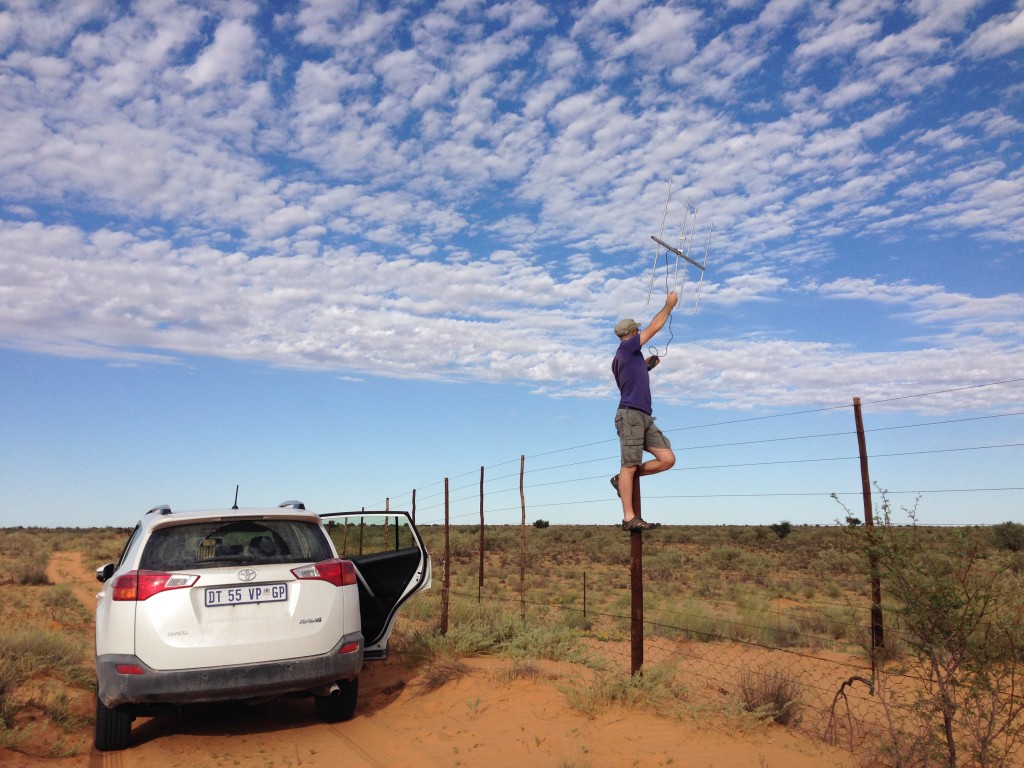
One morning, as we were driving past one of these fences, we suddenly heard a strange thumping noise on the wires. Gabs stopped the car and we spotted a duiker caught helplessly upside down on the fence. It had tried to jump over it, and one of its hind legs had gotten caught in the two uppermost wires. It must have swung down due to the impact, and even its neck had gotten stuck between two of the lower wires. As we rushed out from the car towards it, we noticed that the wires had drawn some blood as well. We immediately set to work freeing the poor duiker which was now shrieking in fear since it probably thought we were going to kill it. Those desperate, helpless cries were heart-wrenching, and trying to imagine how close to death the trapped animal must have felt as we approached it rattled my bones. With clippers, Luc slowly cut the wires on the fence binding her (under Gabs’ directions) as Gabs held on to her front paws so that she wouldn’t kick out and injure the people trying to free her. To calm her down, Gabs suggested we cover her eyes, so I took off my shirt and covered her face with it and she finally stopped shrieking frantically. I then jumped over the fence to hold her third paw steady and then slowly eased it out of its death trap. Then cautiously, gently, we eased her out of the fence on my side and backed off as she somehow found the strength to get out and gingerly run away with numb, bleeding legs. An unforgettable experience!
Clouds during the day are a relative rarity in the Kalahari, but when they do come by, not only do they offer some welcome respite during tracking, but they also lead to some breath-taking sunsets with the bright sand reflecting even more light onto the clouds. They seem to hang much lower than anywhere else I’ve seen (maybe because there was no sufficiently tall reference for scale, such as the Alps outside EPFL), and I felt that if I managed to climb a tall enough tree and threw a stone really hard, it might have pierced the lowest cloud! Of course that’s not true (but maybe gemsbok meat gave me superhuman strength and I just don’t know it yet), and I wonder if there is actually some meteorological phenomenon that makes these clouds hang so low.
A typical day would start off even before the crack of dawn, since getting meerkat-weights as soon as they woke up and shuffled out from their burrows was very important for other parallel studies looking at weight-variation with various parameters such as vegetation, meerkat life-history, age, group, climate, temperature, etc. We would wake up at 4:30 am ourselves, I’d fix myself some breakfast and Gabs and I would leave the house at 5:10 am, reaching the Farmhouse 4 km away at 5:20 am (this 10-minute would often be quite silent, spattered with occasional exclamations of ‘Oh God, I could sleep some more’). At this time, it was usually still pretty dark, and all we would see were just silhouettes of trees in the backdrop of a sky which had just pressed the snooze button.
This was ‘field o’clock’, and it would change depending on the time of the year and when the earliest meerkat group would wake up. From the Farmhouse, we’d leave at about 5:45 am, armed with sunscreen lotion (called ‘suncream’ by the Britishers), sunglasses, heavy-duty boots to guard against the thorny shin-level bushes, and a water-bottle. It’s quite surprising how we don’t realize how much and how soon we get dehydrated there – it’s so dry that I never sweated; the only tell-tale signs I would notice later were thick traces of s
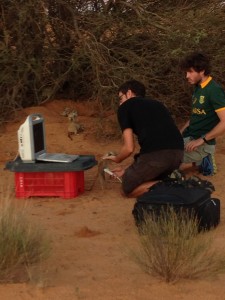 alt on my T-shirt and shorts from all the perspiration that quickly evaporated. We would reach the burrow at about 6:10 am and stay there till the meerkats woke up. Then we would take their morning weights, encouraging them to climb the weighing machine pan by using little pieces of boiled egg and water from a bottle. The pic below shows Peter taking weights right outside the first burrow I visited. A big part of the field biologists’ work is to habituate the wild meerkats to the researchers’ presence so as to facilitate basic important tasks such as weight-measuring and ultrasounds on the females to see if they’re pregnant. Here’s a picture of Peter doing an ultrasound at the same burrow while Nino looks on.
alt on my T-shirt and shorts from all the perspiration that quickly evaporated. We would reach the burrow at about 6:10 am and stay there till the meerkats woke up. Then we would take their morning weights, encouraging them to climb the weighing machine pan by using little pieces of boiled egg and water from a bottle. The pic below shows Peter taking weights right outside the first burrow I visited. A big part of the field biologists’ work is to habituate the wild meerkats to the researchers’ presence so as to facilitate basic important tasks such as weight-measuring and ultrasounds on the females to see if they’re pregnant. Here’s a picture of Peter doing an ultrasound at the same burrow while Nino looks on.
There is a huge temperature variation in the Kalahari. On the first morning at field o’clock, after the huge storm the previous night, the temperature was 14 degrees Celsius. A few days later, while doing some measurements with the magnetometer on the tracking device, I recorded a temperature of 58 degrees Celsius in the Sun at midday, and 43 degrees Celsius in the shade! A difference of about 40 degrees Celsius on the same day… mind-boggling! In the winters, the temperature can drop to about -15 degrees Celsius. I did not have a fan in my room, but since I was mentally prepared for the heat, the discomfort lasted just a few moments at the beginning of the first night. I actually slept quite well – the human body can adapt to so much! In the moments when it was the hottest, and the Sun would penetrate even the layers of laboriously applied suncream and start cooking me alive, I would think of the legendary nomadic Saan bushmen who lived in these parts as hunter-gatherers up till about a hundred years ago. Thinking about how they derived water from the little roots and tubers and leaves in the ground, and walked barefoot on the boiling sand made me forget the heat at these difficult moments, and I would almost laugh at my small discomfort.
Meerkats are charismatic animals. Frankly, if an animal’s favourite food is scorpions and it is specialized in biting the sting off a scorpion before happily munching it, it easily qualifies as a very cool animal in my books. They are intelligent creatures who, from time to time, exhibit very human reactions. They always seem to do things with a definite sense of purpose, and a small group of 4-5 on the move resembles a well-organized military unit – they will scurry in one organized movement in a particular direction, then stop suddenly, stand up on their rear legs and survey the surroundings around them for any dangers or possible paths to follow, and then take off again. They have very keen long-range vision, and when they look up in alarm and lie down flat on the ground, you can be sure it’s a raptor (biologist’s term for bird of prey. How cool is that!) even if you can’t see one immediately. The most feared raptor is the magnificent martial eagle (Babbler Jess’ favourite bird) which I had the exceedingly good fortune of seeing right on the last day on the drive from GV to the Farmhouse with Gabs and Rebecca. A wingspan of 2-3 metres and perfectly orchestrated, calm and graceful movements made it one of the most elegant animals I saw at the Kalahari – it was like watching Federer play a backhand down the line. Anyway, sometimes the meerkats think they’ve seen a raptor, and they scurry to lie flat on the ground, but then it turns out to be a vulture (which scavenges, doesn’t hunt), so then they start breathing easy once again.
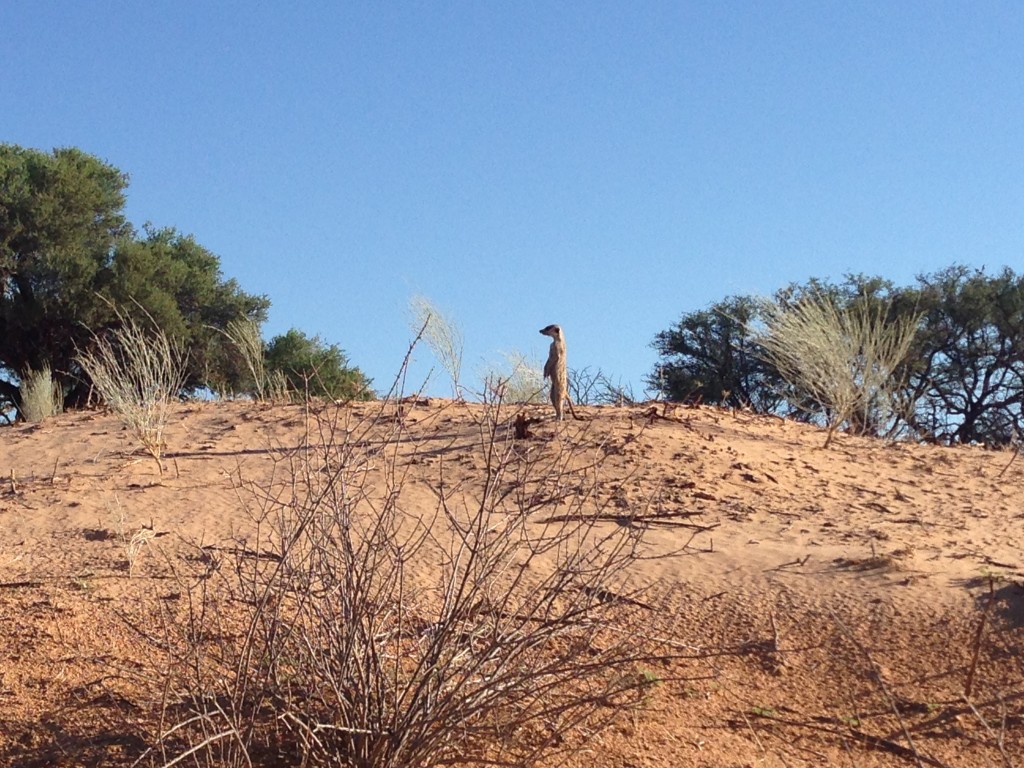
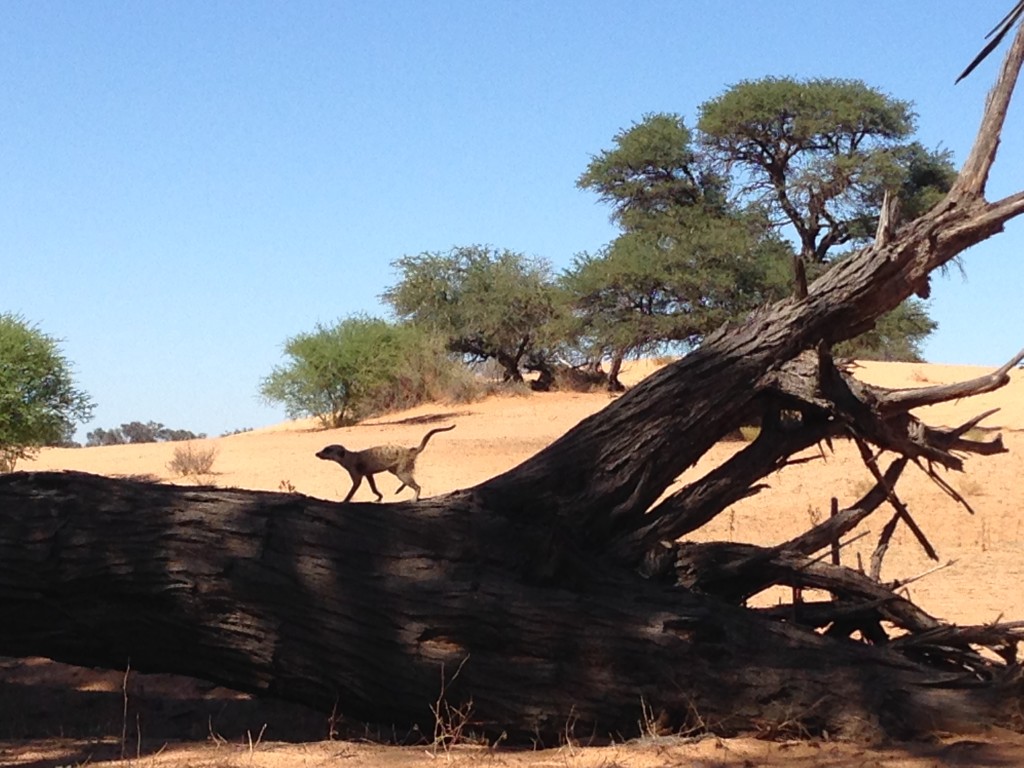 Individual meerkats are identified by specific dye-marks put on them by the volunteers, and also (since the dye-marks wear out within a week), by a tiny transponder chip inserted into their body when they’re very young. Here’s a picture of Jules with the Jaxx group, where the dye-marks are particularly prominent. Note for instance the two meerkats on the right in the picture below – one of them (entering the burrow) has a dye-mark on the back, and the other (exiting the burrow) has two, one on the base of the tail and the other along the tail.
Individual meerkats are identified by specific dye-marks put on them by the volunteers, and also (since the dye-marks wear out within a week), by a tiny transponder chip inserted into their body when they’re very young. Here’s a picture of Jules with the Jaxx group, where the dye-marks are particularly prominent. Note for instance the two meerkats on the right in the picture below – one of them (entering the burrow) has a dye-mark on the back, and the other (exiting the burrow) has two, one on the base of the tail and the other along the tail.
When a new collar has to be put on, or a blood sample has to be taken, or an X-ray needs to be done, the meerkats have to be captured (taken by the tail and put into an opaque sack so that they can’t see anything and hence calm down). They are then anaesthetized using a gas mask, and then these various tasks are carried out. Whenever they’re captured, hydration shots are injected into their muscles to keep them in good health. As a general rule, a given meerkat is never captured more than 4 times a year (to prevent de-habituation). The picture below shows an unconscious meerkat with a collar containing the inertial tracking unit.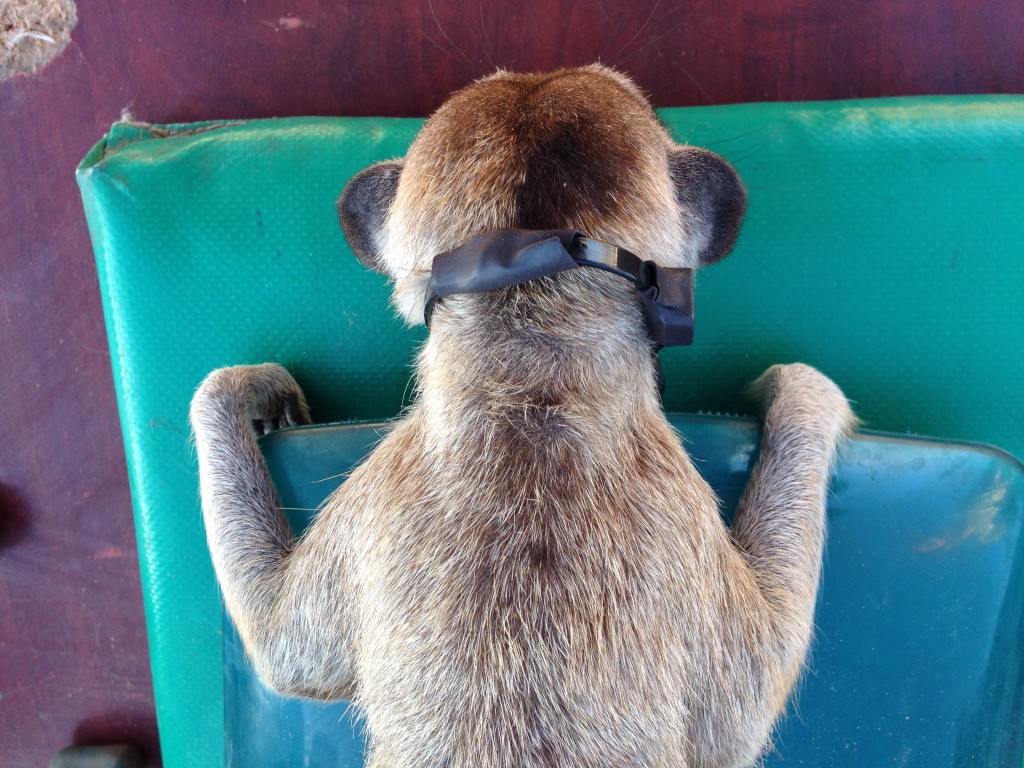
Even though this was just a short 15-day stay in the Kalahari, I saw and learnt so many new things, met so many new people, made so many new friends, and had so much fun cooling off in the pool, playing volleyball, having coffee conversations at GV every day, climbing trees, going for sundowners, feasting at braais (Afrikaans for barbeque), eating the best steak ever at Van Zylsrus hotel, having everyday food consisting of [vegetarians skip this part] springbok, eland, hartebeest or gemsbok meat, or beef, that it seemed as if I’d spent a much longer time at the Kalahari – so complete was my experience. I can’t wait to get back out there after 5-7 months and test the algorithms that I’m going to write in the interim. Here’s a picture of the ‘dispersal team’: from left to right – Nino, Luc, Gabriele, me and Peter.
I think this visit also helped me define one of the important things I want to do during this PhD, and perhaps what to go into after it. I want to combine this field experience with the technology and data analysis techniques that I have learnt and am learning in engineering to answer research questions in the domain of population dynamics, and eventually, animal conservation and management. It pained me to see that the analytical techniques employed in field biology are about 20 years behind the cutting-edge in say physics or computer science. For instance, I believe that if the level of data analysis techniques currently used in particle physics (case in point – direct detection of gravitational waves at LIGO up to an accuracy of one part in 10^21… like measuring the width of a human hair at Proxima Centauri 4 light years away!) could be complemented with cool biological insights from the field, we could answer some critical questions regarding animal movement and management, and help preserve biodiversity and bring about mutually beneficial human-animal coexistence before it’s too late. I think my PhD is already part of this vision, and I am really looking forward to doing my best to bring it to fruition!
Written by Billur Bektaş
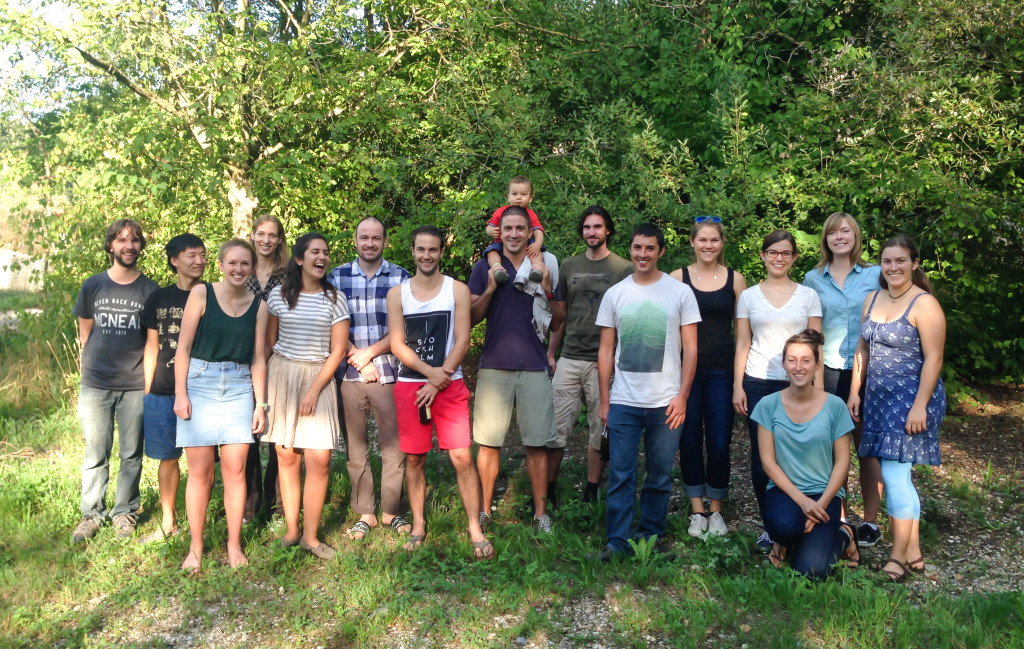
As an undergraduate student at the Istanbul Technical University from the molecular biology and genetics department, my journey in the field of ecology started with voluntary based projects in the TEMA* foundation in Turkey. In this foundation, I had several opportunities to attend ecological literacy instructions, meet people involved in ecology and even share my experience as well as learn with peers. However, guided by my dearest friend Burcu Arık Akyüz in the foundation and inspired by ecologists that I’ve met in my country, a will for deepening the knowledge and understanding for ecology started to grow inside. Since the education I take at my university is focused on molecular biology concentrating mostly on micro level studies, I was unsatisfied and lost. Sure, I was interested in genetics and other molecular based courses but I was deeply curious about several other questions. Namely: “What is the relationship between the environment and populations?” “How are populations and individuals affected by environmental changes?” “Is there a way to formulate and show these relationships and even predict the consequences of environmental changes?” and many more. I was looking for a way to link my education with this new ambition. Thus, thankfully I found out about Arpat. First by name, then in an interview online, then in his publications and at last I had the courage to email him to ask for an internship in his working group. Thankfully again, he accepted! So, I lived the most inspiring month of my life – academically and emotionally. Mainly I worked on rotifers in the laboratory, resurrected the resting eggs from 50 years ago coming from Lake Orta (Italy), a lake that was once contaminated with copper but then recovered. I conducted experiments to collect life table data (survival, and reproduction) and measure body sizes of individuals. During my first week in Zurich, I read different articles mostly about my experiment. I had the chance to take an introductory lecture to matrix modeling and LTREs (Life-Table Response Experiments) analysis from Arpat and we designed the experiment together with the group. In the second and third week, I conducted the experiment and hence encountered different problems in lab. The real experience was not the experiment itself, rather finding solutions to different problems with the group. Finally I learned how to do matrix population modeling and during the last week I analysed the data and sometimes really felt all neurons in my brain… Recalling all those math lectures I once took, trying to learn R-programming and learning something totally new for me… However, at the end I was fascinated by the intelligence behind connecting mathematics with ecology and creating the possibility to use this outcome for conservation biology and for deepening our understanding of ecology and evolution. From the first day to the last, all days passed with learning and curiosity to learn more. And finally my mind was totally clear! This was what I want! Finally I had found my curiosity, my inspiration and my topic for my future study. This feeling was really precious, giving an aim in life and willing to wake up as early as I can in the morning to go to work immediately, discovering more and more, always with a smile on my face and the ambition to carry on.
And now? Now I have many plans and goals for my upcoming years in my undergraduate studies. I have many projects in mind, many articles and books to read, many scientists to meet, many workshops to take… I want to improve my skills in this field on my own due to limited scientific opportunities in my country. However, I am also excited to study ecology in my home country because of its rich biodiversity and different ecosystems.
With this occasion, I want to thank all PopEcol group members to welcome me so friendly, helping me with my other projects and help me to survive socially in Zurich. I want to thank especially Naomi and Stefan for teaching me all these lab skills with discipline and guiding me through the experiment. And for sure I want to thank Arpat to give me the opportunity to be the part of this inspiring group, their scientific work and helping me to find my way in this marvelous journey of ecology.
*TEMA: The Turkish Foundation for Combating Soil Erosion for Reforestation and the Protection of Natural Habitats